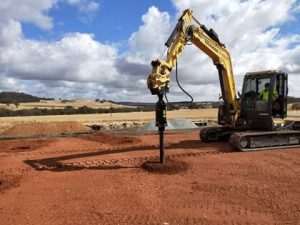Ensuring stability is vital for any structure, be it the erection of a towering skyscraper, a bridge, or a modest residential home. The foundation must be robust enough to bear the building’s weight. One method to secure this stability is through the utilization of pier and auger holes. In this blog post, we will delve into how these features enhance structural stability.
Commonly known as “piling holes” or simply “piles,” pier holes are slender, deep openings bored into the earth, usually with the aid of specialized equipment. They function as the bedrock for structures by housing vertical supports or pilings. These excavations are generally filled with stabilising substances like concrete. Once hardened, this material adds enduring stability to various structures, including edifices, overpasses, and docks. The attributes such as the depth, diameter, and location of pier holes are tailored according to multiple variables like the soil’s makeup, the anticipated structural load, and prevailing environmental circumstances.
Termed as “boring holes,” auger holes are cylindrical cavities skilfully created in the ground using specific auger equipment. These holes serve manifold purposes across various sectors, aiding in essential activities like soil tests, environmental evaluations, and geotechnical studies. By functioning as channels to extract essential geophysical data, auger holes enable experts to make educated choices regarding construction initiatives, extraction ventures, and environmental assessments. The proportions and depths of these holes are scrupulously calibrated based on the project’s unique objectives, facilitating exact data extraction and precise interpretation.
The utilisation of pier and auger holes presents several benefits in terms of enhancing structural stability. For instance, they are particularly effective in locations with volatile soil compositions like clay, sandy regions, or peat-filled areas. The soil in these zones is prone to shifting, which amplifies the risk of structural sinking or lateral movement.
In addition, pier and auger holes can also improve stability in areas where building loads are particularly high, such as high-rise buildings. In such cases, the use of piles can effectively distribute the load, reducing the pressure on the ground and improving the stability of the building.
Furthermore, pier and auger holes provide a versatile solution to a wide range of construction challenges. They can be installed at varying depths, depending on the site conditions and the specific needs of the project. This means that even in locations with diverse soil profiles, or where there are layers of hard rock or water tables to consider, piers and augers can still be employed to ensure stability. Moreover, due to their design and installation process, they cause minimal disturbance to the surrounding environment. This makes them a favoured choice in ecologically sensitive areas or places where traditional excavation methods may be prohibitive.
Another significant benefit of using pier and auger holes is their cost-effectiveness in the long run. While the initial installation might seem costly, the reduced risk of structural damage, foundation repair costs, and extended lifespan of the infrastructure often outweigh the initial investment. This is especially true in areas prone to natural calamities such as earthquakes or floods, where the enhanced foundation stability can prevent catastrophic damage.
Lastly, the adaptability and resilience offered by pier and auger holes cannot be understated. Modern engineering advancements have introduced innovative materials and techniques in their installation, which further enhance their performance. As construction needs evolve and environmental challenges arise, the role of piers and augers remains pivotal in ensuring that structures not only stand tall but also endure the test of time and nature.
In conclusion, pier and auger holes are essential tools in a wide range of applications where stability is crucial. With proper placement and maintenance, they can significantly improve the longevity and safety of structures. Regardless of whether it is a tall building, a small home, a road, or an agricultural structure, the role of piles and auger holes in ensuring stability cannot be underestimated. They are an integral part of many construction and infrastructure projects, and their importance is only expected to increase as we continue to build and develop our physical world.

